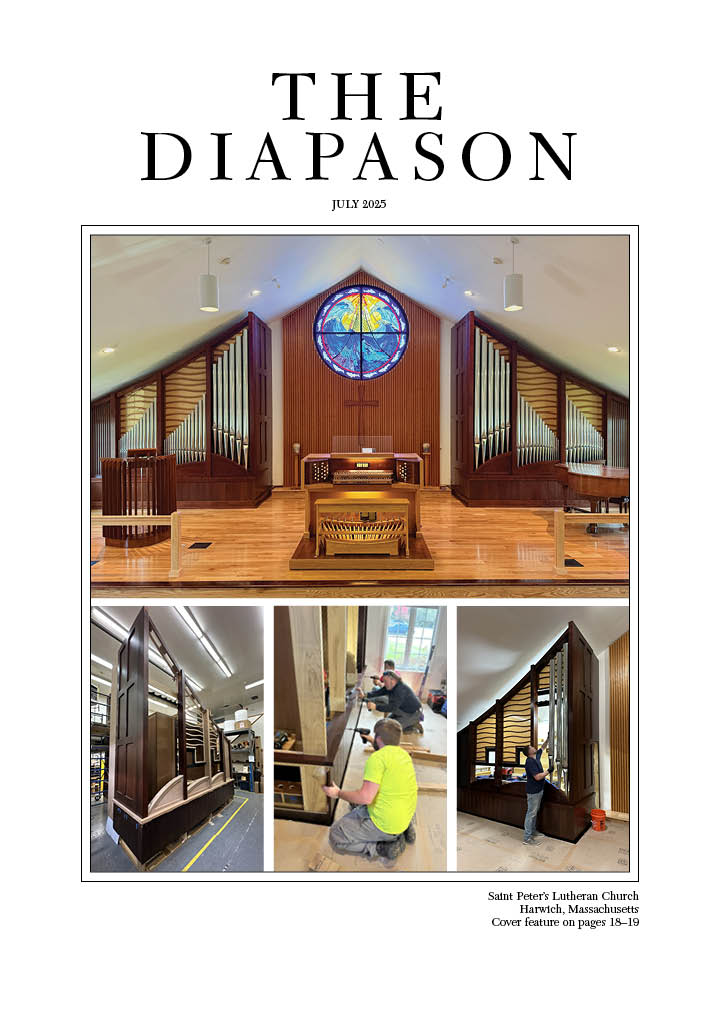WHEN THE PATHS OF MUSIC, ART, AND SCIENCE CONVERGE INTO SOUND
Eastman School of Music’s newly restored 18th century Italian organ will be first of its kind in North America
Rochester, NY — The massive 40-foot container making its way by boat
across the Atlantic Ocean surely belies the musical, historical, and
scientific treasure inside. A carefully disassembled, one-of-a-kind Italian Baroque organ — thoroughly researched, documented, and restored — is eagerly awaited by the Eastman School of Music, as it prepares to take ownership of the only full-size antique Italian organ to be found in North America.
On Monday, July 18, the organ — complete with its 600 pipes and 22-foot tall case — will arrive from Marburg, Germany at its final destination in Rochester. Although it belongs to the Eastman School, the organ will be housed permanently in the historic 1926 Herdle Fountain Court — designed by McKim, Mead, and White — at the Memorial Art Gallery (MAG) of the University of Rochester.
During the first few days, the organ will be completely reassembled on site by German organ builder and restorer Gerald Woehl and a team of experts. A period of six to eight weeks of voicing, tuning, and other adjustments will follow. Recreated in a space amidst late Renaissance and Baroque paintings and sculptures, the organ will takes its place of honor on a custom-built rostrum in the Fountain Court, ultimately to be played by Eastman students, faculty, visiting musicians, and local organists. The inauguration of the organ will be Friday, October 7 (by invitation only) and Saturday, October 8 at the MAG, initiating the week-long Eastman Rochester Organ Initiative (EROI) Festival
with guest artists, public concerts, masterclasses, and symposia surrounding the new organ.
In 1980, Gerald Woehl acquired the unusually well-preserved organ from a Florentine antique dealer. Crafted by an anonymous builder in approximately 1770, a substantial part of the instrument was from an older organ, dating from the late 17th or early 18th century. Most likely, the organ originated in Tuscany or in the Naples region; its lavishly ornamented, carved, and gilded case links it to the Italian court culture of its time. The ornate crown, base, and case are original. The crown ornament is adorned with an unusual motif depicting St. Andrew, and each side of the case is decorated with a 10-foot high painting of a vase of flowers.
Mr. Woehl has been responsible for the restoration, aided by a reference group including the Italian organist and scholar Edoardo Belotti; the German organist and organ expert, Harald Vogel; and Hans Davidsson, Eastman School organ professor and artistic director of the Göteborg Organ Art Center in Sweden.
As this organ is the only known historic one of this size — and in as
lavishly ornamented a case — outside of Italy, its acquisition is even more
significant.
Professor Davidsson describes the Italian organ as being "virtually a
‘living recording’ of the musical sounds heard hundreds of years ago." As
far as what listeners actually will hear, Davidsson reports that "the façade stop (pipe) has a sweet, warm and prompt sound; the flutes a charming and beautiful singing quality, and the full chorus — the ripieno — a rich, powerful, and silvery cascade of complex elegance." No other work of art comprises so many aspects of a culture as does the historic pipe organ. David Higgs, chair of Eastman’s organ department, concurs. "The experience of Rochester’s knowledgeable audience for music, art, and history will be immeasurably enriched by the acquisition of this historic instrument," he says. "It will allow the performance and study of a body of repertoire previously unavailable to both Eastman and the Rochester community." As a research tool, the organ will provide a better understanding of how to interpret and musically shape a vast body of
work created for this type of organ.
Installation of the Italian Baroque organ is the first major accomplishm
ent of EROI, a long-range plan to assemble a collection of new and historic organs unparalleled in North America. When fully-realized, EROI will establish Rochester, New York as the first global center for historical organ performance, research, and preservation in the United States.
For continuing organ and festival updates, visit
www.rochester.edu/Eastman/EROI.
###
Note: Photographs of the organ are available, as are interviews with members of Eastman’s organ faculty and students, and with MAG Director, Grant Holcomb. Media interested in chronicling the historic installation will be permitted on site by request only during specific museum hours.
Eastman School of Music’s newly restored 18th century Italian organ will be
Amy Blum
Related Content
A four-day festival (22-25 October) of marking the tenth anniversary of the installation of Eastman’s Italian Baroque Organ at the Memorial Art Gallery
Host Facility
Eastman School of Music - Memorial Art Gallery
Location
Memorial Art Gallery, Rochester, NY
Time
October 22-25
Event Month & Year
Performing History: The Italian Baroque Organ and Its Cultural Intersections
GENERAL INFORMATION
A four-day festival (22-25 October) of concerts, masterclasses, and paper sessions, marking the tenth anniversary of the installation of Eastman’s Italian Baroque Organ at the Memorial Art Gallery, Rochester, NY.


